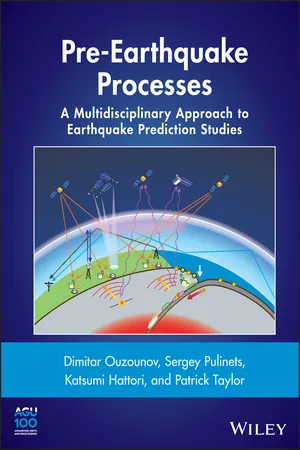
Pre-Earthquake Processes
A Multidisciplinary Approach to Earthquake Prediction Studies
- English
- ePUB (mobile friendly)
- Available on iOS & Android
Pre-Earthquake Processes
A Multidisciplinary Approach to Earthquake Prediction Studies
About this book
Pre-Earthquake signals are advanced warnings of a larger seismic event. A better understanding of these processes can help to predict the characteristics of the subsequent mainshock. Pre-Earthquake Processes: A Multidisciplinary Approach to Earthquake Prediction Studies presents the latest research on earthquake forecasting and prediction based on observations and physical modeling in China, Greece, Italy, France, Japan, Russia, Taiwan, and the United States.
Volume highlights include:
- Describes the earthquake processes and the observed physical signals that precede them
- Explores the relationship between pre-earthquake activity and the characteristics of subsequent seismic events
- Encompasses physical, atmospheric, geochemical, and historical characteristics of pre-earthquakes
- Illustrates thermal infrared, seismo–ionospheric, and other satellite and ground-based pre-earthquake anomalies
- Applies these multidisciplinary data to earthquake forecasting and prediction
Written for seismologists, geophysicists, geochemists, physical scientists, students and others, Pre-Earthquake Processes: A Multidisciplinary Approach to Earthquake Prediction Studies offers an essential resource for understanding the dynamics of pre-earthquake phenomena from an international and multidisciplinary perspective.
Frequently asked questions
- Essential is ideal for learners and professionals who enjoy exploring a wide range of subjects. Access the Essential Library with 800,000+ trusted titles and best-sellers across business, personal growth, and the humanities. Includes unlimited reading time and Standard Read Aloud voice.
- Complete: Perfect for advanced learners and researchers needing full, unrestricted access. Unlock 1.4M+ books across hundreds of subjects, including academic and specialized titles. The Complete Plan also includes advanced features like Premium Read Aloud and Research Assistant.
Please note we cannot support devices running on iOS 13 and Android 7 or earlier. Learn more about using the app.
Information
Part I:
Historical Development of Pre‐Earthquake Phenomena Studies
1
International Cooperation in Pre‐Earthquake Studies: History and New Directions
ABSTRACT
Table of contents
- Cover
- Table of Contents
- Preface
- Part I: Historical Development of Pre-Earthquake Phenomena Studies
- Part II: Latest Physical Models and Concepts of Pre-Earthquake Processes
- Part III: Pre-Earthquake Seismic Phenomena
- Part IV: Ground Geochemical and Electromagnetic Observations of Major Seismicity
- Part V: Atmospheric/Thermal Signals Associated with Major Earthquakes
- Part VI: Ionospheric Processes Associated with Major Earthquakes
- Part VII: Interdisciplinary Approach to Earthquake Forecasts/Predictions
- Index
- End User License Agreement